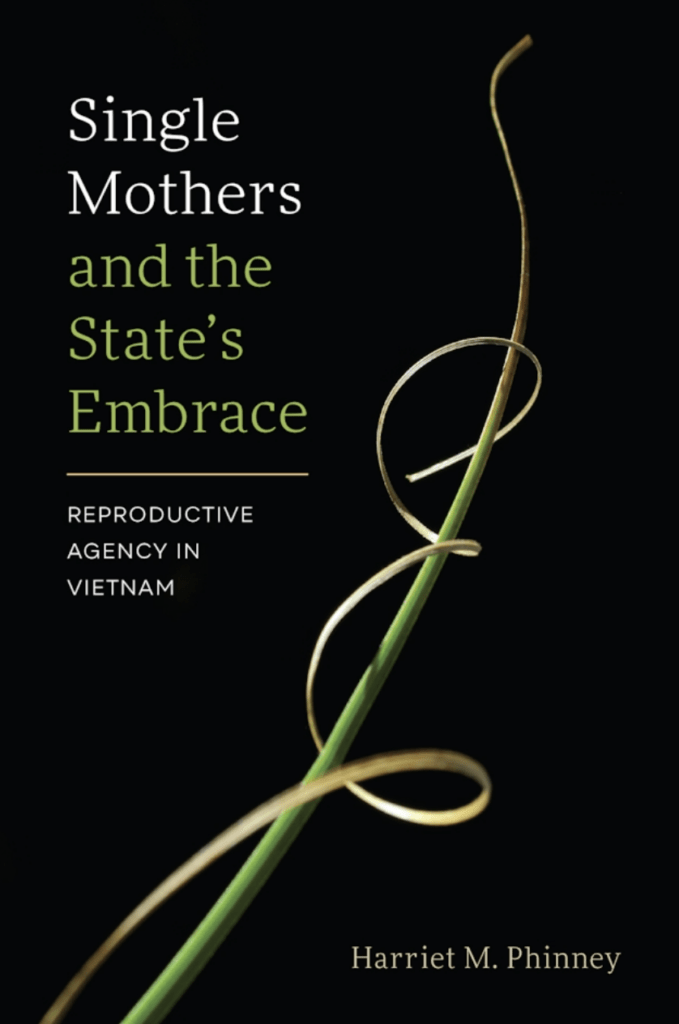Reviewed Book
Single Mothers and the State’s Embrace: Reproductive Agency in Vietnam By Harriet M. Phinney, Seattle: Washington University Press. 2022. 219 pp.

Tine M. Gammeltoft
University of Copenhagen
In her philosophy of natality, Hannah Arendt reflected on the capacity of human beings to turn loss and devastation into new forms of being in the world. Harriet M. Phinney’s Single Mothers and the State’s Embrace offers a poignant ethnographic case of such bringing into being of the new. The book documents how single women in Vietnam turned the tragic loss of lives during the Second Indochina War into occasions for reproductive inventiveness and new forms of family building, while also exploring how single women of the subsequent generation pursued motherhood.
Single Mothers and the State’s Embrace is based on ethnographic fieldwork conducted in and around Vietnam’s capital Hanoi over 22 years. The main bulk of fieldwork was conducted in 1995–1996, with shorter follow-up visits between 2004 and 2017. During the initial fieldwork, Phinney worked with 35 single women who had “asked for a child” (xin con), while also interviewing social scientists and government officials and reviewing policy documents and mass media discourses. “Asking for a child” entailed getting pregnant out of wedlock by intention, conceiving a child with a carefully selected—usually married—man. In this northern Vietnamese male-oriented kinship system where non-marital childbearing was considered a morally compromising transgression and dominant gender norms defined femininity in terms of chastity, passivity, and subservience—asking for a child was a radical reproductive strategy.
In Part 1, titled “Maternal Desire and the Postwar Marital Terrain,” Phinney analyzes the socio-historical and demographic context of this reproductive moment in Vietnam’s history, showing how women who asked for a child had seen their marital chances seriously diminished by war. Some had lost the man they loved, others had spent their youth years contributing to the national cause, finding themselves unable to marry when the war ended. This part of the book offers detailed first-person accounts of child-seeking women’s sentiments and motivations, highlighting both the challenges they encountered and the sympathy and social support they received. These are moving stories—slightly ethnographically limited by the reliance on interviews, of which many were carried out under the supervision of Women’s Union cadres—but powerful and engaging. In this part of the book, Phinney brings us to northern Vietnam, making the mothers she met in the field come alive to the reader and reminding us of the multifaceted and often unexpected consequences of war.
Part 2, “Reproductive Agency and Vietnamese Governmentality,” considers “asking for a child” through the lens of governmentality. Phinney shows how single women’s rights to have children were set forth and supported by the socialist state through legislation such as the 1986 Marriage and Family Law. Asking for a child was rendered possible, Phinney argues, through a combination of maternal desires and affordances created by state legislation and discourses. The law carved out subject positions that single women took up, turning themselves into new forms of mothers. Although asking for a child could be seen as a radical break with a male-oriented kinship system that normally leaves little room for women’s sexual agency, this practice and the social support provided for it were also, Phinney shows, new manifestations of long-standing moral associations between motherhood and womanhood. This part of the book offers intriguing insights into the interplays between human agency and state governance, showing how the Vietnamese state itself changed in response to individual women’s actions and initiatives.
Part 3, “Xin Con at the Turn of the Century,” is based on ethnographic materials from the author’s visits to Vietnam between 2004 and 2017. This part of the book explores reproductive agency among single women of the next generation—those having children in the 1990s. Based on shorter research visits to Hanoi and interviews with six women encountered through personal networks, the author highlights these single women’s pathways to motherhood—including their reasons for dismissing marriage—while also discussing the state legislation that supported single motherhood in this new era. The reproductive strategies of this younger generation, Phinney argues, differ markedly from those of the previous generation: rather than being driven by demographic imbalances and conventional notions of appropriate womanhood, these women’s strategies constitute explicit critiques of the unequal gender and kinship arrangements that northern Vietnam’s patrilocal/patrilineal kinship system entails.
Although the insights into Hanoi life at the turn of the century given here are vivid and compelling, the conclusions drawn in this part of the book seem bolder than justified by the ethnographic evidence. Basing large and generalizing claims about the cultural projects of Vietnam’s “next generation of single women” on selected public events and the accounts of six women in Hanoi seems slightly questionable. This, however, does not diminish the importance of the rich contributions made by the book as a whole. A key contribution of Single Mothers and the State’s Embrace is its framing of the practice of “asking for a child” as not simply a locally specific reproductive strategy undertaken in response to gendered postwar and pro-natal pressures—but also as powerful evidence of the generative power of human creativity. “Xin con,” Phinney writes, “emerged out of the debris of the American War and out of revolution. But not all was debris….” (p. 95).
Single Mothers and the State’s Embrace offers a nuanced and thought-provoking account of single Vietnamese women’s breaks with conventional kinship practices, while also being a moving testimony to human capacities to bring forth the new in the wake of destruction. Further, the book offers interesting and detailed insights into the dynamic and complex interplays between the exercise of state power and the force of human agency. Single Mothers and the State’s Embrace contributes significantly to Vietnam studies, gender/kinship studies, policy studies, and demographic and historical anthropology. Written in clear prose and an engaging tone, it is suited for undergraduates as well as for advanced students and scholars in anthropology and beyond.